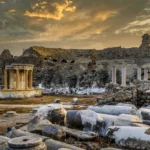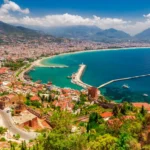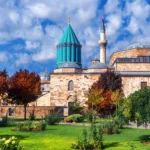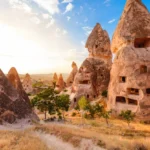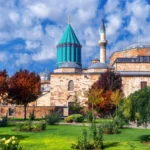
Türkiye Mithraism and Hellenism Tour
Turkey, a country straddling Europe and Asia, has a rich historical tapestry woven from the threads of various cultures, religions, and philosophies. Among these, Mithraism and Hellenism stand out as pivotal influences that shaped the spiritual landscape of the region. This article seeks to explore a unique tour of Turkey that highlights these two ancient systems, elucidating their significance and enduring legacies through archaeological sites, historical narratives, and cultural practices.
Understanding Mithraism
Origins and Beliefs
Mithraism, named after the deity Mithras, originated in Persia and spread throughout the Roman Empire during the 1st to the 4th centuries AD. It was a mystery religion, primarily practiced by men, that emphasized salvation, light, and the struggle between good and evil. Mithras, often depicted slaying a bull, symbolized fertility and rebirth. The religion involved complex rituals, initiation ceremonies, and communal meals, fostering a sense of brotherhood among its followers.
Mithraism’s Spread in Turkey
Mithraism found fertile ground in various parts of Turkey, especially in cities like Istanbul (formerly Byzantium and Constantinople), ancient Ephesus, and Tarsus. The significance of Mithras in these areas illustrates how the region served as a crossroads between East and West, allowing for the exchange of ideas and religious beliefs.
Archaeological Sites Related to Mithraism
- Mithraeum of Tarsus: The Mithraeum in Tarsus is one of the best-preserved examples of Mithraic temples. Dating back to the 2nd century AD, it consists of a small cave-like structure adorned with reliefs depicting the god Mithras in various scenes. Tourists can explore the intricate symbols and learn about the rituals that took place here.
- Mithraeum in Istanbul: Beneath the streets of Istanbul, remnants of a Mithraeum were discovered, indicating the prevalence of Mithraism in Byzantium. This location provides insights into the urban spiritual life of early Christians and pagans coexisting in a rapidly changing city.
- Ephesus: As a major center of trade and culture, Ephesus also demonstrated the influence of Mithraism. While the Temple of Artemis is more famous, underground sanctuaries dedicated to Mithras reveal the dual religious practices that thrived in the area.
Exploring Hellenism
Roots and Characteristics
Hellenism refers to the culture, ideals, and patterns of life established by the ancient Greeks during the classical era, which persisted long after the fall of the Hellenistic kingdoms. It emphasized philosophy, art, architecture, and the sciences. The Hellenistic period began after Alexander the Great’s conquests and marked a time of unprecedented cultural exchange.
Hellenism in Turkey
Turkey, integral to the ancient Greek world, was home to numerous Hellenistic cities where Greek art and philosophy flourished. Cities like Pergamon and Ephesus were significant centers of Hellenistic culture.
Key Sites of Hellenism
- Ephesus: Ephesus, one of the best-preserved ancient cities in the world, showcases the grandeur of Hellenistic architecture. The famous Library of Celsus, the Great Theatre, and the Temple of Artemis (one of the Seven Wonders of the Ancient World) exemplify the artistic and architectural achievements of the Hellenistic period.
- Pergamon: Another monumental site, Pergamon, features the Acropolis with its impressive altar of Zeus and the Asclepius sanctuary, which was a center of healing. The combination of breathtaking views and ancient ruins makes Pergamon a must-visit for those interested in Hellenism.
- Halicarnassus: Known for the Mausoleum of Halicarnassus, one of the Seven Wonders, this city exemplifies Hellenistic architecture and its blending with local traditions, making it a crucial point of interest for cultural tourism.
The Intersection of Mithraism and Hellenism in Turkey
While Mithraism and Hellenism may seem distinct, their paths often crossed in ancient Turkey. Both systems offered similar themes of rebirth, the afterlife, and the struggle between light and darkness. This intersection became a site of religious syncretism, particularly during the Roman Empire, where followers of Mithras and adherents of Hellenistic philosophy found common ground.
Cultural and Religious Integration
The blending of Mithraism and Hellenism is evident in various artifacts, such as inscriptions, sculptures, and architectural designs that reflect both traditions. These integrations manifested in shared spaces where people practiced rituals, reflected on philosophical teachings, and fostered community bonds.
Planning the Mithraism and Hellenism Tour
A tour of Turkey focusing on Mithraism and Hellenism can provide an enriching experience for travelers interested in history and culture. Here’s a suggested itinerary highlighting key sites and activities:
Day 1: Arrival in Istanbul
- Explore the Basilica Cistern to see early Byzantine architecture.
- Visit the Mithraeum of Istanbul to learn about the ancient religious practices.
Day 2: Ephesus
- Discover the grandeur of Ephesus. Key sites include the Library of Celsus, the Great Theatre, and the remains of the Temple of Artemis.
- Join a guided tour that discusses the coexistence of Hellenism and Mithraism in the area.
Day 3: Pergamon
- Visit the Acropolis of Pergamon, where you can marvel at the Altar of Zeus and the Asclepius Sanctuary.
- Engage in a session at the Pergamon Museum to better understand the Hellenistic art and culture.
Day 4: Tarsus
- Explore the Mithraeum of Tarsus, captivated by its intricate carvings and historical significance.
- Visit the Tarsus Waterfall and the Cleansing of St. Paul, reflecting on the city’s rich religious history.
Day 5: Halicarnassus
- Tour the Mausoleum of Halicarnassus, learning about its architectural innovations.
- Stroll through the old town, experiencing the profound influence of ancient Greek culture still resonating today.
Conclusion
The journey through Turkey exploring Mithraism and Hellenism unveils a fascinating interplay of ancient beliefs, cultural practices, and architectural wonders. As travelers delve into the remnants of these two influential movements, they not only gain insight into the past but also witness how these ancient systems shaped modern Turkey’s identity. From the impressive ruins of Ephesus to the mystical ambiance of the Mithraeum, Turkey serves as a vibrant canvas illustrating the rich tapestry of human history. Embarking on this tour not only enriches one’s knowledge but also offers a profound appreciation for the enduring legacy of Mithraism and Hellenism in the heart of Turkiye.




